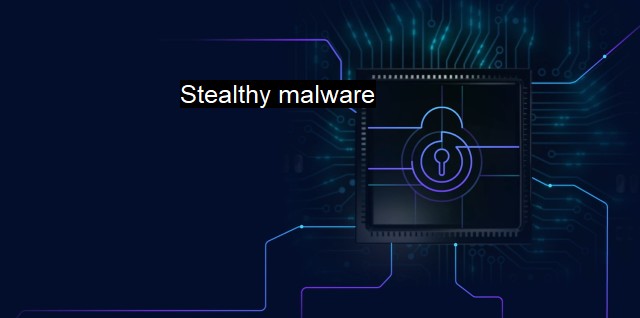What is Stealthy malware?
The Stealing Threat: Understanding Stealthy Malware and How it Bypasses Antivirus Protection
Stealthy malware, as the term suggests, operates covertly. It is designed to infiltrate computers or networks without being detected by traditional security systems. Understanding the nature, capability, and the threat it poses is crucial to businesses and individual users who want to guard their digital data and assets effectively.From a cybersecurity standpoint, stealthy malware is among the most dangerous types of harmful software. The primary goal of these software is surreptitious intrusion into the target system or network, with the objective of stealing sensitive data, jamming networks, damaging computer systems, spying, or taking control of the system.
Historically, the types of stealthy malware that pose considerable threats include rootkits, botnets, spyware, adware, trojans, ransomware, and cryptomining malware. A vital aspect of stealthy malware is that they often adopt polymorphic tactics, changing their own code to escape detection by antivirus defenses. They could also execute maneuvers to hide when analyst tools try to inspect digital memory or take on characteristics of legitimate files to blend in and fly under the radar.
Rootkits, for instance, are stealthy malware that offers continuous privileged access to a computer while actively hiding its presence. The term rootkit originated from Unix, but extends beyond to also include any malware that aims to remain concealed and undetectable on the host machine. A good example of this is Stuxnet, which exploited zero-day vulnerabilities and used rootkit strategies to remain undiscovered while wreaking chaos on Iran's nuclear program.
Botnets are yet another form of stealthy malware, amassing groups of infected computers which can then be controlled remotely by the hacker, generally without the knowledge of the users of the affected systems. With command of this vast “zombie army,” the attacker can perform distributed denial-of-service (DDoS) attacks, manipulate online poll results, spread malware or even demand ransom.
Trojans, on the other hand, are stealthy malware that disguise themselves as harmless or beneficial programs to trick users into installing them only for the malware to then compromise the systems They are responsible for several cyberattacks, including the infamous Zeus and Emotet attacks, which obtained banking information from multiple organizations worldwide.
Ransomware is a form of stealthy malware that encrypts the victim's data and blocks access until a ransom is paid. A notorious example is the WannaCry ransomware attack on businesses worldwide. In a more stealthy method, cryptomining malware secretly takes advantage of computing resources to mine cryptocurrency and generates income for attackers.
The stealthy nature of these malware makes them powerful tools in the hands of cybercriminals. Their ability to remain undetected for extended periods of time allows them to cause extensive damage before they are discovered and mitigated.
Modern cybersecurity protocols remain the key strategy for combating stealthy malware. Users applying rigorous digital hygiene can prevent many attacks. Regularly updating systems, avoiding suspicious downloads and unsecured websites, employing secure authentication models, and using cybersecurity solutions like antivirus software, firewalls, intrusion detection systems can help identify and remove stealthy malware.
Antivirus software uses a variety of security measures like real-time scanning, behavior tracking, and heuristics to detect unusual patterns that hint at an intrusion, making it an essential tool in combating stealthy malware. But it's a combination of user awareness, protective technology, and proactive security measures that provide the most sensible defense against stealthy malware.
Indeed, while stealthy malware poses a significant threat to individuals and businesses alike, with the appropriate cybersecurity measures, protocols, and strategies in place, these harmful software can be effectively managed and combatted.

Stealthy malware FAQs
What is stealthy malware?
Stealthy malware is a type of malicious software designed to avoid detection from antivirus programs and other security solutions. It is designed to operate in the background, often without the knowledge of the user or the system administrator.How can stealthy malware be detected?
Stealthy malware can be detected through the use of advanced security solutions, such as behavior-based detection, machine learning algorithms, and heuristic analysis. These solutions are designed to detect abnormal behavior or activity within a system and identify potential threats that may be hiding in the background.What are some common examples of stealthy malware?
Some common examples of stealthy malware include rootkits, Trojan horses, and spyware. Rootkits are designed to hide their presence on a system and provide a backdoor for attackers to gain access to sensitive information. Trojan horses are malicious programs that disguise themselves as legitimate software and can be used to steal data or compromise a system. Spyware is a type of malware that monitors a user's activity and collects information without their knowledge or consent.How can I protect myself against stealthy malware?
To protect yourself against stealthy malware, it is important to use a reliable antivirus program and keep it up-to-date. You should also be cautious when downloading and installing software from the internet, and only download from trusted sources. Additionally, you should regularly update your operating system and other software to ensure that any security vulnerabilities are patched. Finally, it is important to educate yourself on safe computing practices and be aware of the latest threats and trends in the cybersecurity landscape.| | A | | | B | | | C | | | D | | | E | | | F | | | G | | | H | | | I | | | J | | | K | | | L | | | M | |
| | N | | | O | | | P | | | Q | | | R | | | S | | | T | | | U | | | V | | | W | | | X | | | Y | | | Z | |
| | 1 | | | 2 | | | 3 | | | 4 | | | 7 | | | 8 | | |||||||